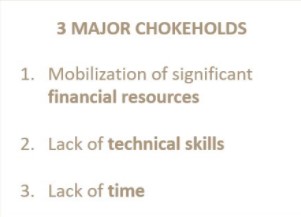In this blog, we outline a straightforward framework inspired by Ksapa’s team expertise of driving efforts across supply chains. However varied, climate approaches and tools have not substantially proven impact for the last decade. They basically have proven to lack traction from a broad enough supplier base to demonstrate tangible impact against the global climate agenda. As a result, we include complementary directions for organizations to design and implement a robust climate program capable of onboarding their entire supply chain.
This article is content coming from our briefing paper. If you wish to discover all of our briefing papers, please click here.
Investors and Companies Must Mobilize Suppliers to Achieve 1.5°C Global Warming Strategies
The business case for all-encompassing climate action is crystal clear:
- GHG emissions must drastically be reduced. To limit global warming to 1.5°C, global greenhouse gas (GHG) emissions must drastically and immediately be reduced. More specifically, these must be halved by 2030 in order to achieve net neutrality no later than 2050. Concomitantly, some of the carbon we have already emitted into the atmosphere must be removed
- Business Action is Crucial. Companies are encouraged to publicly set and implement targets to reduce GHG emissions across their entire value chain. They too must halve their GHG emissions by 2030, in line with the scientific input summarized in the IPCC’s WG1 6th Assessment report
- Climate Action is Good Business. Companies that progress more quickly will boost the much-needed climate transition. They will also secure a significant competitive advantage in the process, ultimately enhancing their own long-term resilience
Key Action Points to Implement a 1.5°C Climate Strategy Across the Supply Chain
The following table presents the different components of a supply chain approach capable of onboarding priority suppliers in a 1.5°C global warming trajectory. It is designed for companies (buyers) and investors (engagement teams) alike.*
| Commitment | Internal Control Systems & Risk Management | |
| Publish science-based commitments and identify priority suppliers | Set a scientifically aligned and achievable target and craft a realistic plan for your organization to achieve it. This target should involve demanding suppliers halve their GHG emissions BY 2030 at a very minimum, to match the 1.5°C global warming ambition. Such targets may include the following: – % or number of strategic suppliers set to halve their GHG emissions – Reducing supplier emissions by a specified percentage and target year – Specific % of spending allocated to halving their GHG emissions – Public statement of suppliers of their 1.5°C target – Clear interim goals in the run up to 2030 to track tangible progress. | – Understand the main GHG hotspots across your supply chain, the corresponding GHG reduction potential, supplier maturity and buyer leverage – Prioritize which suppliers to engage with directly for maximum impact |
| Align procurement approach accordingly and engage priority suppliers | Clearly communicate expectations to suppliers via any of the following: – A letter or email from Group leadership or procurement – Updating the Supplier Code of Conduct – Communicating to suppliers what resources are available to support them in tackling climate action | Climate action relies on engagement. This can only work provided suppliers can understand the business case for them. Procurement must therefore incentivize suppliers as well, via: – Setting up a forum for dialog and listening to what suppliers have to say, how they can innovate and contributing to hitting the target – Encourage long-term relations with mobilized suppliers, empower their efforts to yield more predictability in your business outlook |
| Track data in order to foster emulation across the broader supply base | Define a clear process to track supplier climate performance at least annually, ideally by leveraging suppliers’ publicly-reported indicators | Publicly disclose progress against 1.5°C Supplier Targets. Relevant indicators may vary from one company to another. That said, possible targets may include the following: % or number of engaged suppliers with a goal to halve emissions before 2030 % or number of suppliers progressing towards halving emissions by 2030 % or amount of spend with suppliers who have a target to halve emissions by 2030 Use relevant channels for reporting, such as sustainability report/website, or specific platforms Include these results in the company’s wider climate/sustainability reporting. |
Getting It Right Demands More than Just Supplier Engagement
Over the past decade of our working alongside multiple Fortune 500 companies, the above recommendations have been tried and tested. We have also explored the benefits of collaborative initiatives, which have, overall, demonstrated clear benefits in terms of supporting supply chain engagement in favor of climate action.
With this constitutes a sound start, it clearly is not enough to deliver on the ongoing decade of action. We need more ambitious decarbonization targets and we need the supply chain to be onboard. Two critical components indeed remain missing, which investors and companies alike must tackle to foster sweeping climate action.
- BUILDING INTERNAL ALIGNMENT AND CORPORATE POLICY RESPONSIBILITY
Governments intrinsically value growth, job creation and wealth creation, placing them soundly. under the influence of both business and finance. That is not necessarily a bad thing. This is merely a statement of fact. As such, Corporate Political Responsibility can be defined as the alignment of statements and political influence. Should Corporate Political Responsibility continue not to deliver on climate action, governments and business are doomed to face growing discontent and conflictual situations with stakeholders – youths in particular.
There can be no such alignment as long as corporate and governmental climate pledges are allowed to contrast with the net neutrality global agenda. That can for example take the form of a corporate commitment to stop investing in a carbon-intense business when the company make no such investments in the first place. Subject to similar doubt, governments can claim to ban domestic oil and gas exploration, despite not having any such resources to start with. Much in the same way, companies and governments may announce seemingly massive climate-related investments without putting their money where their mouth is year down the line. There were nevertheless many such commitments during COP26 as with past iterations.
The climate urgency demands more than fluffy commitments from a few organizations. We need a plan that effectively commits the global collective to climate action. As such, we believe ensuring businesses outline sound climate plans boils down to addressing the following priorities:
- Internal alignment = Business organizations must achieve internal alignment across every function and business unit against a common goal – that is, progress against climate action. This can notably involve significantly restructuring organizations to put climate front and center of their every P&L statements;
- Collaboration = Business associations from Washington DC, Brussels, Beijing and other similar critical locations strive to shape regulation on behalf of the highest emitters and the broader international community. As such, they provide a key opportunity for external alignment. Together, they engage in capacity-building, certification and tax incentives. Taking in concert, they prove instrumental in changing market rules and shaping alignment along entire value chains.
2. BRINGING FUNDING TO SUPPORT SUPPLIERS IN THEIR CLIMATE EFFORTS
Thanks to our collective expertise of corporate climate policy and action plans, our teams are regularly called upon to address recurring bottlenecks in the ongoing global energy transition. We indeed mean to help businesses and investors bridge the gap in time, resources and expertise.
We dubbed our innovative approach V.CHET, which strands for Value Chain Energy Transition. That way, Ksapa packages technical expertise and financing solutions to support corporate energy transitions. Operationally, the main chokeholds to the commitment and implementation of energy transition projects are threefold. That is – limited investment capacities, lack of expertise and lack of time.

Building on the dynamics of green finance, we developed a mechanism that combines the skills to match corporations’ needs. Meanwhile, we design innovative financing solutions tailored to business needs in such a way as to effectively bring together financial partners and investors.
Designed as part of a long-term and integrative logic, V.CHET in fact combine 3 components:
- Defining a value chain-wide energy transition strategy: through our analyses, we deliver recommendations per key topics, an overarching vision and comprehensive monitoring
- Developing a financing plan to match recommended strategies
- Operationally implement targeted solutions (energy efficiency, renewable energy, etc.) thanks to the mobilization of a technical ecosystem of partners.
Conclusion
Companies willing to be serious commitment on climate must therefore deploy the following approach:
- Define a credible Net Zero strategy, which should obviously include supply chain
- Conduct a robust technical assessment to identify appropriate levers including decarbonation, energy efficiency and circularity solutions
- Involve innovative financial mechanisms to bring the external capital required to accelerate and amplify transitions with no excuse from operations and suppliers to move faster and harder on climate transformation
We stand at the ready to make sure we don’t operate in the next decade relying exclusively on solutions which have not proven to generate the expected impact across the past decade.
Clarity, accuracy and innovation are therefore the critical ingredients making climate transformation of supply chains possible at a time when it becomes more urgent than ever.
Author of several books and resources on business, sustainability and responsibility. Working with top decision makers pursuing transformational changes for their organizations, leaders and industries. Working with executives improving resilience and competitiveness of their company and products given their climate and human right business agendas. Connect with Farid Baddache on Twitter at @Fbaddache.






